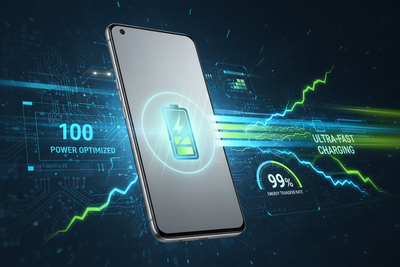Introduction
In today's fast-moving digital world, electronic waste management has become an essential link to sustainable power electronics design. Due to the rapid growth in technology, the life span of modern electronic devices is increasingly becoming shorter. Countless smartphones, laptops, batteries, and electrical components are thrown away every year; they form part of an increasing global problem of E-waste. The integrated approach where electronic waste management plays a central role in creating sustainable power electronics that minimizes environmental harm, considering that electronic waste is not well managed:
Sustainable design is no longer an option but an imperative. The use of effective strategies for E-waste management in conjunction with innovations in the field of power electronics design can enable the industry to move closer towards a greener, more circular economy. The following blog explores how proper waste management supports sustainable design, reduces resource depletion, and leads to a cleaner planet.
Understanding Electronic Waste and Its Global Impact
E-waste encompasses any discarded, broken, or abandoned electronic devices and components. Examples of these include computers, cellular phones and laptops. With rapidly developing technology, the rate at which E-waste is produced around the globe keeps increasing.
Studies have estimated that the world produced over 62 million tons of E-waste, with the number projected to increase significantly in the near future. These wastes contain hazardous materials such as mercury, lead, and cadmium that may damage human health and ecosystems if not disposed of properly.
By incorporating e-waste management into product design, manufacturers can create systems that are more conducive to recycling, reuse, and repair. This helps conserve valuable materials and enables sustainable power electronics design, thus guaranteeing energy-efficient devices that will also keep in step with global environmental objectives.
The Link Between Electronic Waste Management and Sustainable Design
Understanding how management of electronic waste contributes to sustainable design in power electronics requires consideration of the connection between product life cycle and the resultant environmental footprint.
In the design of each new electronic product, there is a need for consideration to be given to the stages that follow its life and what exactly happens later on. This includes easy disassembly of components, recovery of raw materials, and recyclability for reuse in other future products. This philosophy in design, called DfS, sets a foundation for long-term environmental benefits.
For example, the introduction of modularity in device architecture by manufacturers allows parts to be upgraded rather than discarded. This will directly reduce E-waste generation and help embrace sustainable power electronics design principles wherein components such as semiconductors, capacitors, and batteries can be reused or refurbished.
Additionally, it is reinforced at the board level using biodegradable materials and lead-free soldering. For this reason, electronic waste management isn't just about disposal but is actually about planning the whole life cycle of a product to minimize harm and maximize efficiency.
Key Principles of Sustainable Power Electronics Design
To achieve sustainable power electronics design, several key principles have to be considered, all closely related to efficient electronic waste management:
a. Energy Efficiency
The control and conversion of electrical energy come under the realm of power electronics. Designing devices that consume less power and generate minimal heat will ensure sustainability. In addition, it includes optimizing circuits and using wide-bandgap semiconductors that improve energy conversion efficiency.
b. Material Recovery and Recycling
The recycling of gold, copper, silver, and palladium from E-waste reduces the demand for newly mined metals. This saves mineral resources and reduces pollution. In a sustainable design, first priority is given to the usage of materials that are easier to be separated and recycled.
c. Design for Disassembly (DfD)
At the end of a product's life cycle, sustainable electronics should be easily dismantled. DfD makes it easy to separate components such as the circuit board, batteries, and casings effectively for reuse and recycling purposes, avoiding landfill waste.
d. Longer Product Lifespan
Indeed, manufacturing with quality, upgradability, and repair possibilities prolongs the life of the devices. This helps reduce E-waste generation, therefore aligning with the goals of a circular economy.
e. Eco-Friendly Manufacturing
Limiting hazardous substances and using cleaner manufacturing processes ensures the creation of sustainability from the ground up. When electronic waste management is integrated into early design stages, environmental safety becomes part of every stage of production.
Each of these principles emphasizes the requirement for designing with an end-of-life strategy, turning waste into a resource and contributing to sustainable power electronics design.
Recycling and Reuse in the Management of Electronic Waste
Recycling and reuse represent the backbones of electronic waste management. Most electronic devices have valuable parts that are recyclable, hence recoverable and able to find their way back into production lines.
For example, metals such as aluminum, copper, and gold are recycled and reused in new circuit boards and connectors, while plastic casings could be reprocessed into the manufacture of new components or packaging material. Batteries could also be refurbished or repurposed for secondary applications related to energy storage. This circular approach will help in closing the production loop, with fewer raw materials being extracted from the environment. It also supports the development of sustainable power electronics, as manufacturers can rely on reclaimed materials instead of newly mined ones. Moreover, refurbishing also contributes to the affordability and access of devices, extending product utility and reducing the buildup of wastes. In a nutshell, electronic waste management wholly strengthens environmental protection and economic sustainability through recycling, reusing, and rethinking designs.
Challenges in Implementing Electronic Waste Management
While electronic waste management is essential for sustainable power electronics design, several challenges hinder its full-scale adoption:
-
Lack of Global Standardization: Different countries have varying regulations for E-waste collection and recycling, leading to inefficiencies.
-
Informal Recycling Sectors: In many developing nations, E-waste is handled by informal recyclers using unsafe methods, which leads to environmental pollution and health hazards.
-
Complex Product Design: Many electronics are not built with disassembly in mind, making material recovery difficult and expensive.
-
Consumer Behavior: People tend to upgrade frequently, leading to faster product turnover and more waste.
-
Economic Constraints: Recycling processes can be costly without government incentives or proper infrastructure.
To overcome these challenges, governments and manufacturers must collaborate to implement strict E-waste management policies, promote consumer awareness, and adopt innovative power electronics design strategies that prioritize sustainability.
The Future of Sustainable Power Electronics Design
The future of sustainable power electronics design lies in combining green materials, renewable energy integration, and advanced manufacturing methods. Innovations such as 3D printing, AI-driven design optimization, and nanotechnology can help create more efficient and recyclable components.
The growing global emphasis on E-waste management means future electronics will be designed with complete lifecycle accountability. We can expect to see:
-
Increased use of recycled materials in circuit boards and casings.
-
Eco-friendly packaging and reduced plastic content.
-
Energy-efficient chips and modules that consume less power.
-
Greater adoption of renewable energy-powered manufacturing plants.
-
A global push for circular economy practices in electronics production.
Ultimately, the combination of electronic waste management and sustainable design will lead to a world where technology and ecology coexist harmoniously.
The Role of Consumers and Policy Makers
Consumers and governments play vital roles in ensuring successful electronic waste management. While manufacturers focus on sustainable power electronics design, users must adopt responsible habits—such as recycling old devices, avoiding unnecessary upgrades, and purchasing eco-friendly electronics.
Policy makers can promote sustainability through:
-
E-waste collection programs that simplify recycling for consumers.
-
Incentives for manufacturers that use recyclable materials.
-
Strict regulations against improper disposal and export of hazardous waste.
-
Public awareness campaigns on the importance of responsible disposal.
By aligning design innovation with responsible consumption and strong governance, E-waste management becomes a shared responsibility, paving the way for a truly sustainable electronics industry.
Conclusion
In conclusion, electronic waste management supports sustainable power electronics design by creating a bridge between innovation and environmental responsibility. Through effective E-waste recycling, design optimization, and energy efficiency, the electronics industry can minimize its ecological footprint and preserve valuable natural resources.
The journey toward sustainability involves everyone—manufacturers designing for disassembly, consumers practicing mindful disposal, and policymakers enforcing green regulations. By adopting these measures, the global community can ensure that modern technology continues to advance without compromising the health of our planet.
Sustainability is not just about reducing waste—it’s about designing smarter, cleaner, and more efficient products that make technology a true ally of the environment.
FAQs
Q.1. What is electronic waste management?
Electronic waste management is the process of collecting, recycling, and safely disposing of discarded electronic devices to minimize environmental harm.
Q.2. How does electronic waste affect the environment?
Improper disposal releases toxic substances that pollute soil, air, and water, harming both ecosystems and human health.
Q.3. What are the key benefits of sustainable power electronics design?
It reduces energy consumption, extends product life, minimizes waste, and promotes resource efficiency.
Q.4. How can consumers contribute to electronic waste management?
Consumers can recycle old devices, choose eco-friendly electronics, and avoid frequent unnecessary upgrades.
Q.5. What is the future of E-waste and sustainability?
The future lies in circular design, where all electronic products are recyclable, reusable, and energy-efficient, leading to a cleaner planet.





















